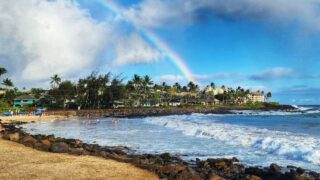The Hawaii you are planning for in 2026 is not the Hawaii you visited even a couple of years ago. Some changes have been slow, others have arrived suddenly, and many are only now beginning to shape how planning a trip here actually feels.
One reader told us she spent an entire afternoon trying to figure out which beaches on Maui now require reservations, which state parks have added fees, what the new hotel tax structure will be, and where on earth to park reasonably. That kind of homework has now become part of the Hawaii travel equation.
If Hawaii is anywhere on your 2026 radar, the rules, systems, expectations, and even the booking platforms you once knew are shifting under your feet. Hawaii remains an unquestionably remarkable place to visit, but heading here now takes more intention than it once did.
Loyalty program overhaul.
For longtime Hawaii travelers, one of the most personal changes is the end of HawaiianMiles and the end of a standalone Hawaiian Airlines. For decades, Hawaiian provided a familiar structure for interisland trips, West Coast flights, and that sense of loyalty to an airline deeply rooted in the islands. That ended formally in October when all accounts migrated to Atmos Rewards under Alaska.
While the change was technically straightforward, we continue hearing from readers who feel unmoored by the shift. And we do too. Jeff is still chasing the mileage credits he has not received. Some say they still do not know what their old miles are worth for travel. Others wonder whether their elite status will carry the same weight when it comes solely to Hawaii.
This transition has reshaped loyalty for many people who once felt that HawaiianMiles was one of the few constants in their Hawaii travel life. Our previous look at this shift appears in Atmos Rewards Just Gutted Hawaii Flyers and Hawaii Travelers Dump Airline Loyalty For Price Loyalty.
Next spring, Hawaiian is planned to join the oneworld alliance. For some travelers, this is a welcome expansion of redemption routes and earning opportunities. For others, it signals another layer of complexity on top of everything else that is already changing. The core emotional shift is that loyalty, once built around a Hawaii-based airline, becomes part of a vastly larger and global system where not everything will feel familiar.
Alaska Hawaiian integration realities.
The Alaska and Hawaiian integration moves from headlines to lived experience in 2026. A single reservation system is expected next year, though the exact timing of the spring rollout remains fluid. Once it arrives, it will influence how you book your flights, view your itinerary, check upgrade paths, and handle changes when a trip goes sideways.
Readers have already told us that their Atmos miles from recent Hawaiian flights have not posted (same with us), and a few have reported mismatches between elite status and benefits. One reader mentioned that booking a Hawaiian flight today and checking the reservation next week can feel like interacting with two different airlines. The integration story is unfolding in real time, and the identity questions around it continue to evolve. You can find more on that in Hawaiian CEO Issues Apology Letter Amid Integration Woes.
On the aircraft side, there will be less change in 2026. The beloved Hawaiian Dreamliners are largely gone and will not be returning to Hawaii flights as far as anyone knows. Hawaiian’s 717 interisland fleet remains in service with no published retirement schedule, and the widebody A330 interiors have no announced retrofit timeline. For visitors, that means the physical experience on board should remain familiar even as the systems and branding that surround those flights continue shifting.
Fees and access expansion.
One of the clearest changes for 2026 is the expansion of visitor fees, and these will be felt across all islands.
Starting January 1, a new statewide green fee of 0.75 percent will be added to the transient accommodations tax. That will bring the total state lodging tax to 11%. Combined with county surcharges and the general excise tax, visitors will pay close to 19% in taxes before any resort or destination fees are added.
Cruise passengers were also expected to see new taxes, but legal challenges suggest that could be delayed. For deeper context on how visitors are reacting to those charges, see Visitors Say Hawaii’s New Fees Cross The Line.
State park fees continue expanding as well. Fourteen locations now require nonresident parking or entry charges. Rainbow Falls, Wailua River, Tantalus, and Kekaha Kai are among the recent additions. We covered that expansion in Hawaii Expands Visitor State Park Fees To 14 Locations. A couple can easily pay $20 to visit a place that once had no fee at all. Residents remain exempt, creating the two-tier structure that many readers have described in comments as a growing source of tension.
A reader named Denise told us she and her husband used to visit several parks in a day. Now they choose one spot and stay there because the combination of fees, reservations, and timed entry makes moving around feel more complicated. Honolulu continues to adjust its pilot projects, while Maui’s Kamaole Beach parking system, announced in 2022, remains stalled with no exact timeline but still expected in 2026. All of this leaves visitors in 2026 with access rules that vary not just by island but often by individual location.
Vacation rental uncertainty.
Legal vacation rentals across Hawaii continue to tighten rather than expand. Maui’s most recent plans for enforcement actions remain stalled, though the county is still committed to phasing out thousands of nonconforming rentals over time. Kauai’s caps have been fixed for years, and Honolulu continues to enforce its rules in neighborhoods under pressure from rental demand. The overall trend is a shrinking pool of legitimate rentals at the same time that demand continues to largely hold steady.
Visitors planning 2026 trips should book earlier and expect higher nightly rates. It also helps to verify that a rental is in good standing before committing. That can mean asking owners for permit numbers, checking county databases, or working with established management companies that clearly identify legal units. Some readers have told us they are uneasy about booking too far ahead because they do not know whether their chosen rental will still be allowed to operate by the time they arrive, even though no major rule changes are expected immediately.
A reader named Karen told us she and her family still plan to visit Maui in 2026, but they have reduced their stay from two weeks to one because even though no major rule changes are expected immediately.
Prices are not coming down.
Even as Hawaii visitor numbers flatten, the cost of being here continues to rise. Shipping remains one of the biggest drivers. The 25.75% Young Brothers rate increase touches most things that arrive in Hawaii, including groceries, restaurant supplies, hotel linens, and construction materials. Insurance and labor costs remain elevated as well.
One reader told us she paid more than $700 in combined taxes and fees for a recent five-night condo stay on Kauai. The nightly rate itself was already high before any surcharges were added.
For 2026 travelers, the practical takeaway is that bargain-hunting in Hawaii requires strategy rather than luck. Watching for airfare sales, traveling midweek, locking in refundable accommodation as early as possible, and planning activities with a realistic budget all matter more now.
Waiting for last-minute price breaks is unlikely to work. The baseline cost of a Hawaii vacation has shifted and is not expected to fall to any degree in the coming year.
What is still uncertain.
Not every 2026 change has a clear path. The statewide green fee is certain, but the cruise ship tax component may be delayed indefinitely while legal challenges continue. Maui’s new beach parking program, approved in concept for Kamaole I, II, and III, is still scheduled for early 2026 but remains unimplemented as the county works through permits, kiosks, and enforcement details.
Counties continue to adjust access policies as shoreline conditions and visitor volumes shift. Several additional state parks are under review for future visitor fees, and officials already have the authority to add them without new legislation.
A Kauai resident named Leilani told us she hopes visitors come prepared in 2026, understand the rules, and see some of the added fees as part of caring for a place that millions of people use each year. Other readers have said that the uncertainty around rentals, access, and taxes is pushing them to think more carefully about how long they stay and which island they choose.
Hawaii remains entirely doable for 2026. It simply requires more awareness of loyalty changes, fee structures, access rules, and booking systems than many visitors have needed in the past.
Get Breaking Hawaii Travel News






